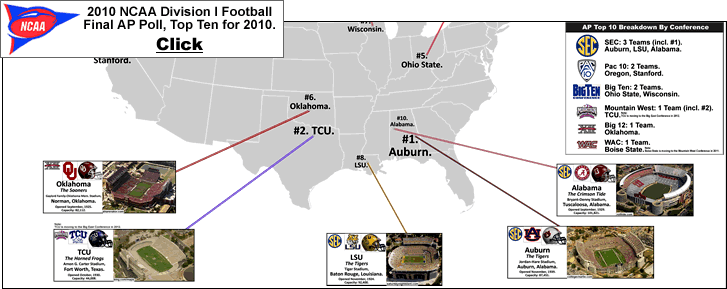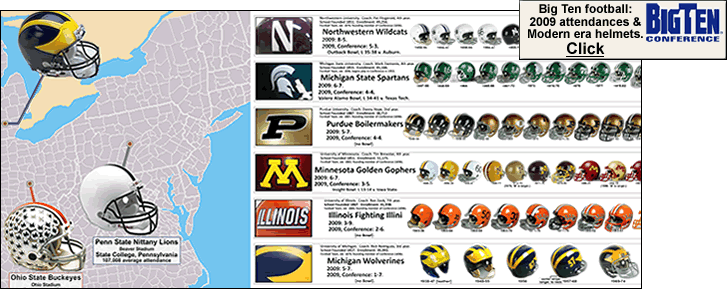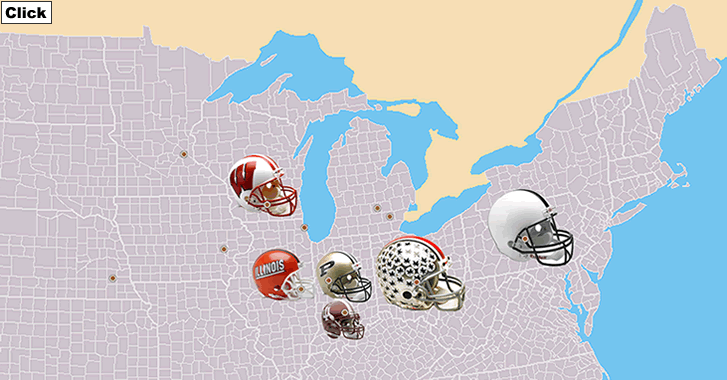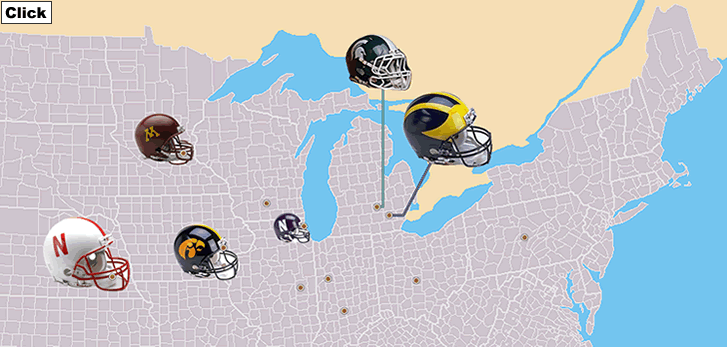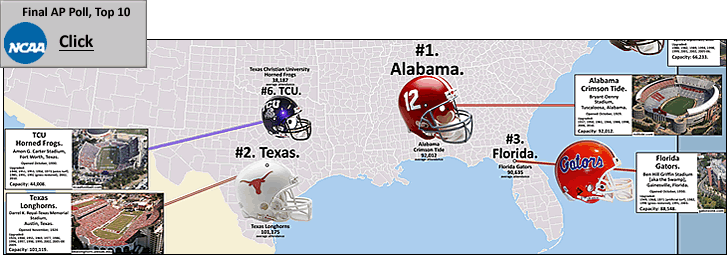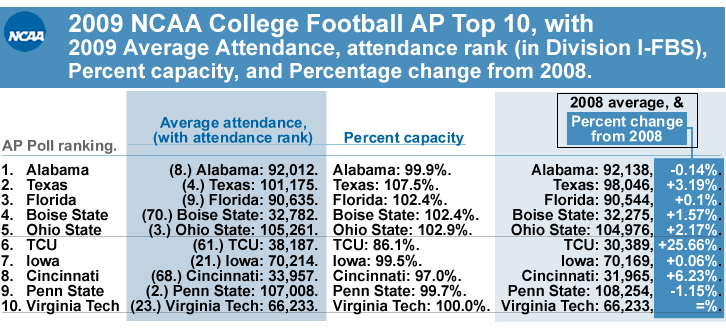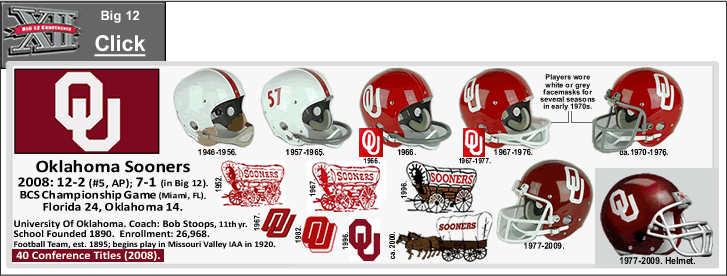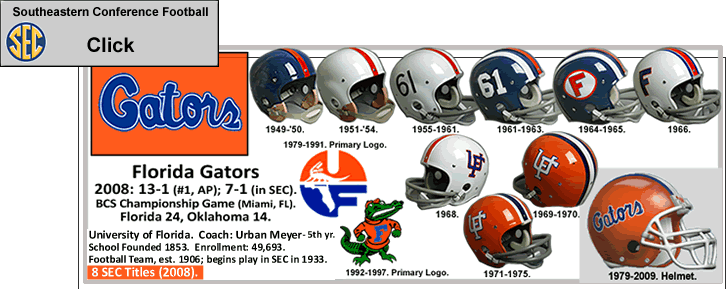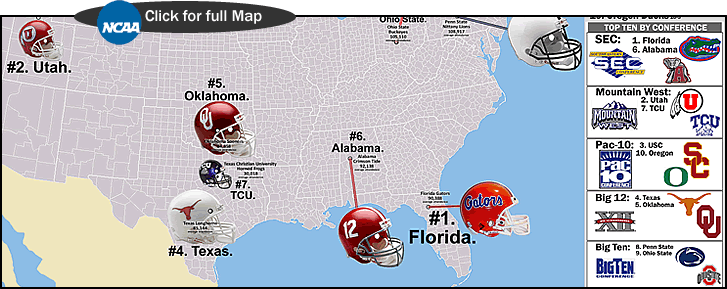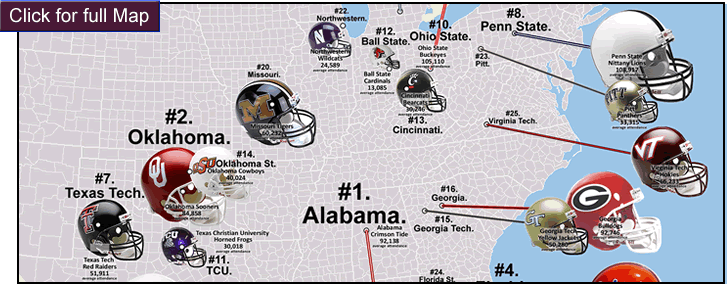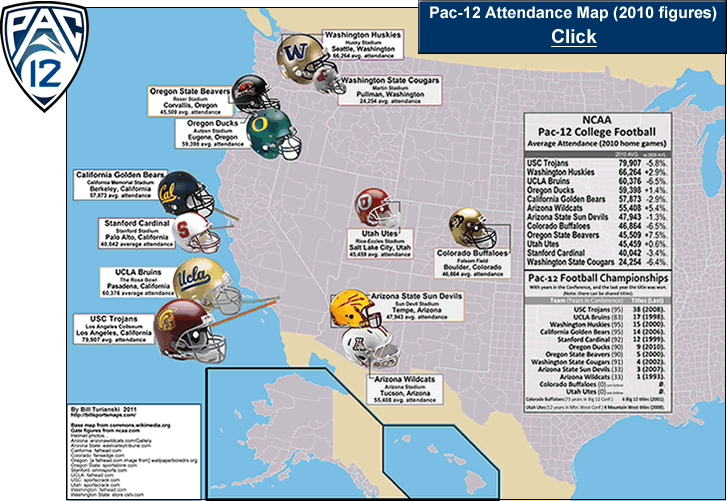
Pac-12 Attendance map (2010 figures)
…
…
This post has 5 gifs. The first gif, which you can see by clicking on the image above, is an attendance map of Pac-12 football teams, using 2010 home average attendances. Locations of the teams’ home stadiums are shown. Each team’s helmet (current home-uniform or base-uniform helmet) is shown, and is sized to reflect 2010 average attendance – the higher the average attendance, the larger the helmet. For gate figures, I used info from this pdf (from NCAA.com) – pdf, 2010 NCAA Division I FBS Attendance. The list in the upper-middle of the map page shows the teams’ 2010 average attendances, as well as percent-change from the 2009 season. Below that is a list of all-time titles for the Conference (PCC/AAWU/Pac-8/Pac-10/Pac-12, from 1916 to 2010). Years spent in the conference by each team is also noted. At the bottom, I have included the titles won from the 2 new teams’ previous conferences (Colorado coming over from the Big 12 Conference, and Utah coming over from the Mountain West Conference).
A brief history of the Pac-12 Conference and it’s previous permutations can be found 4 paragraphs down.
…
The second gif (click on image below) is a chart of the modern-era helmet histories of the 12 teams in the Pac-12. By “modern-era” I mean the era of plastic composite football helmets, which began from the time right after World War II to the mid-1950s. During this 1946-to-circa-1955 time period, some college football programs took longer than others to stop using the decidedly less-safe leather helmets. I am pretty sure this chart is not 100% comprehensive, because I suspect a couple teams (Arizona and Oregon State) had earlier helmet designs at the start of the plastic composite helmet era (circa 1950-59), but I could not find confirmation of that. I pinned down helmet designs, helmet design changes, and dates the helmet designs were used mainly through two excellent sites – The Helmet Project (at National Champs.net), and the brilliant Helmet Hut.com. I can’t thank the people who run these sites enough. I don’t know the Helmet Hut guys’ names, but the Helmet Project site is the work of Charles Arey, so thanks very much, Charles.

One new aspect of the layout of the helmet history chart – the current [2011] helmet(s) of each Pac-12 team can be found in the gray-shaded section at the far right of the chart page. First, the large illustrations of each team’s primary helmet are displayed (these illustrations are from the excellent site called MG’s Helmets). Then there are small side-view & front-views of all the teams’ current helmets shown (these illustrations are from each team’s Wikipedia page [which, in their original form include the full uniforms], and were drawn by Wikipedia-user Kevin W). {All of Kevin W.’s college football teams’ uniforms illustrations can be found at a spot in Wikipedia, here}. So thanks very much to MG down there in Birmingham, AL; and thanks to Kevin W.
…
A brief history of the college football conference now known as the Pac-12
The conference that is now named the Pacific-12 (Pac-12) was formed in 1959. It’s roots are in the Pacific Coast Conference, which began play for football in 1916, and existed from 1915 to 1959. Founding schools in the Pacific Coast Conference (PCC) were California (of Berkeley, CA), Washington (of Seattle, WA), Oregon (of Salem, OR), and Oregon State (of Corvallis, OR). The following year, 1917, Washington State (of Pullman, WA) joined. Stanford (of Palo Alto, CA) joined the next year, 1918. In 1922, the conference expanded to 8 teams with the addition of Southern California [ie, USC] (of Los Angeles, CA), and Idaho (of Moscow, ID). Montana (of Missoula, MT) joined in 1924. The PCC swelled to 10 teams when UCLA (of Los Angeles, CA) joined in 1928. Montana left the PCC in 1950, to join the Mountain States Conference. The dominant schools in Pacific Coast Conference football were the four California schools. UCLA won 12 Conference titles, both USC and California won 11 titles, and Stanford won 8 titles. The 6 other schools won a total of 14 titles, with the highest being Oregon with 5 titles. The two Rocky Mountain schools, Idaho and Montana, never won a football title.
The divide between the 4 California schools and the other 6 schools was also evident in another way. Many university leaders in the California schools considered the Northwest schools academically inferior, and advocated a split to form a separate California conference, for schools that held a higher standard of the student athlete.
So it is ironic that the split-up of the Pacific Coast Conference came about after a scandal involving illegal payments to players on the UCLA and USC teams. UCLA officials and coaches eventually admitted to widespread payments to players, and in turn blew the whistle on phony USC programs that paid players. 3 of the 4 California schools (but not Stanford), as well as Washington, were eventually implicated in the pay-for-play scandal, and the PCC disbanded in 1959.
In July, 1959, the Athletic Association of Western Universities was formed, comprising California, Stanford, UCLA, USC, and Washington. This in spite of the fact that many at Stanford had wanted UCLA to be expelled for their part in the pay-for-play/ slush fund scandal. For it’s first few years, 1960-’62, the AAWU was popularly known as the Big Five. The Northwest schools were initially blocked from joining, but Washington State was able to join in 1962, and it became known as the Big Six. Oregon and Oregon State were finally able to join in 1964. Idaho was never invited, and stayed independent until joining the Big Sky Conference in 1963.
In 1968, the AAWU changed it’s name to the Pacific 8 Conference, aka the Pac-8.
In 1978, the conference added two schools from the Western Athletic conference: Arizona State (Tempe, AZ), and Arizona (Tuscon, AZ), and changed it’s name to the Pacific-10 Conference, aka the Pac-10.
In 2011, the conference added two schools, one who left the the Big 12 Conference – Colorado (Boulder, CO); and one who left the Mountain West Conference – Utah (Salt Lake City, UT). The conference changed it’s name to the Pacific-12 Conference, aka the Pac-12. The football conference branch of the larger all-sports Pac-12 changed the structure of it’s competition by instituting a 2-division format (North and South Division), with a Pac-12 football championship final to be played each December (at the home field of the divisional finalist with the best record).
…
The 3rd gif and the 4th gif show the new breakdown of teams by division in Pac-12 football (North Division and South Division).


The crucial detail is that all 4 California teams – 2 in the North Division (Cal and Stanford) and 2 in the South Division (UCLA and Southern Cal) – will be playing each other every season. That and other details concerning the new divisional structure are shown in the center of both divisional maps here via a screenshot I took from en.wikipedia’s page on the subject {the link for that page is at the very bottom of this post}.
…
Below is the 5th gif, the 2011 Maryland Terrapins’ new alternate helmet and new alternate uniforms -
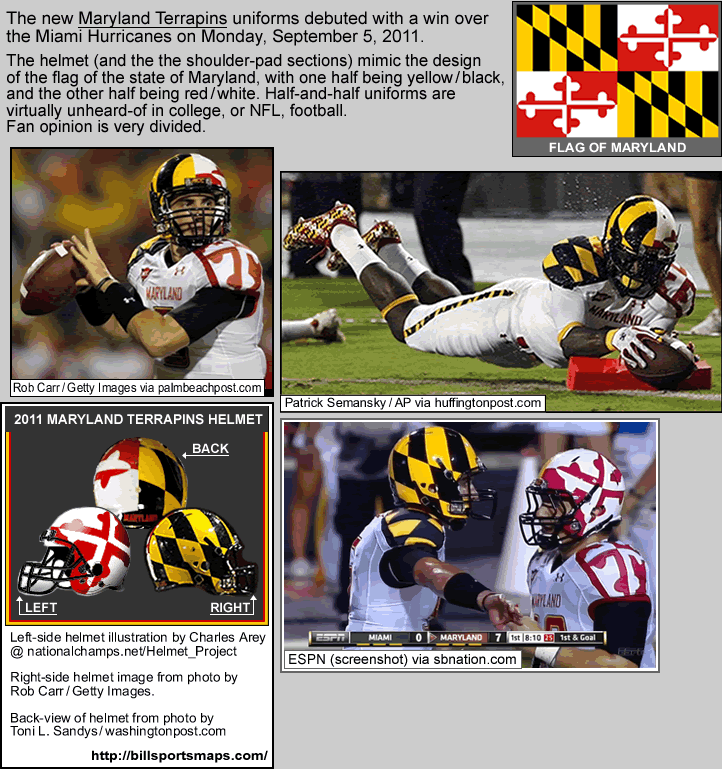
From HuffingtonPost.com, from 5 September 2011,’University Of Maryland Football Uniforms By Under Armour Create Buzz On Twitter (PHOTOS/TWEETS)‘.
http://www.nationalchamps.net/Helmet_Project/
From PalmBeachPost.com, ‘Maryland Terrapins’ new uniforms elicit a storm of fashion criticism‘. [Note: you can also see the new alternate helmets and new alternate uniforms of Georgia and Boise State at this link.]
From Washingtonpost.com, ‘University of Maryland football defeats Miami in season opener [w/ gallery]‘.
From SBnation.com/NCAA-football, ‘PHOTO: Maryland’s New Helmets…‘.
_
Credits for Pac-12 Helmet History Chart -
Thanks to http://www.sports-logos-screensavers.com/NationalCollegiateAthleticsAssociation.html .
Thanks to Helmet Hut/College helmets.
Thanks to the Helmet Project page at http://nationalchamps.net/Helmet_Project/pac10.htm
Thanks to MG’s Helmets, for current [2011] Pac 12 football helmets.
Thanks to jennypenny1 at this address at E-Bay – http://stores.ebay.com/The-Football-Helmet-Store/NCAA-Game-Used-Helmets-/_i.html?rt=nc&_fsub=289111719&_sid=877628519&_trksid=p4634.c0.m14.l1513&_pgn=2
Thanks to Amazon.com for the photo of the circa 1960 Oregon State helmet.
Thanks to MonsterMarketplace.com for the Cal 1987-2007 helmet photo, here.
…
Credits for Pac-12 Attendance Map (2010 figures) -
Thanks to these sites for the helmet photos…
Arizona new white helmet (white, with asymmetrical red/white/navy stripes, and with white face mask), from the Arizona Wildcats official site’s gallery page, here.
Arizona State new home helmet (sunflower yellow, new pitchfork logo, with maroon face mask), from an article at the EastValleyTribune.com site, here.
Cal helmet from Fathead.com, here.
Colorado helmet from Fan’sEdge.com, here.
Oregon helmet (primary-uniform helmet) from Wallpaperborders.org, here.
Oregon State helmet from SportsBlink.com, here.
Stanford helmet from OmniSports.com [link was broken], here.
UCLA helmet from Fathead.com, here.
USC helmet from SportsCrack.comhere.
Utah helmet from SportsCrack.com, here.
Washington University helmet fromFathead.com, here.
Washington helmet from Fathead.com, here.
Washington State new home helmet (with grey, not maroon, face mask), here [link was broken to Cougars team shop, here].
…
Thanks to the contributors to the pages at en.wikipedia.org, ‘2011 Pacific-12 Conference football season‘.
Thanks to NCAA.com, for attendance figures.






